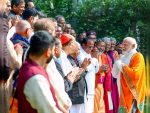New Delhi: In the dense smog that engulfed India’s capital early this month, a baby named Vaishnavi gasped through the night.
Inside the concrete room that her father and mother rent for $20 a month, they took turns staying up, laying a hand on her rib cage, feeling it move up and down. Her coughing fits became so violent that she vomited, milk mixed with ropes of sputum. Three times they thought she would not survive until morning.
Twenty miles away, inside an elegant, high-ceilinged house in an elite neighborhood, a 4-year-old boy named Mehtab was also struggling to fill his lungs with air.
His mother, heavily pregnant, sat beside him, administering corticosteroids through a nebulizer mask once an hour. But once an hour wasn’t enough. Mehtab’s father fought waves of panic as they waited for the sun to rise. The boy looked, to him, like a fish suffocating in the air.
For seven days at the beginning of this month, a thick cloud settled over this metropolis of 20 million people. Held in place by a weather system known as an anticyclone, the pollution was pulled inward and down, trapping the people of this city in concentrations of hazardous micro-particles never before recorded here.
The rich, who are buffered from so many of Delhi’s dangers, bunkered themselves inside, filtering out particles in their own air through expensive, high-tech purifiers. But the nature of air pollution is that it is pervasive. Researchers in China have found that exposure rates for the rich and the poor are virtually indistinguishable.
As average daytime levels of PM 2.5, the most dangerous particles, passed 700 micrograms per cubic meter, 28 times the concentration the World Health Organization considers safe, the authorities in Delhi took the unprecedented step of shutting schools for three days. Protesters marched in surgical masks, carrying posters likening the city to a gas chamber.
Eventually, the wind picked up, bringing the city’s pollution level down to its usual, atrocious winter level. But the air quality in north India will remain dangerous for months, as poor people fight the dropping temperature by burning things — leaves, plastic, anything — to stay warm.
There is a clear body of evidence that death rates, emergency room visits, heart attacks and strokes all rise when particulate concentrations are high. Recent data from the W.H.O.’s Global Burden of Disease project indicates that the number of premature deaths related to air pollution in India has caught up with the number in China, and is now surpassing it.
The worst-hit will be the very old, who are susceptible to heart disease and stroke, and the very young, whose lungs are so taxed by polluted air that they cannot develop normally. Children are more vulnerable because they are smaller, with shallower breaths and higher heart rates; they breathe more air.
In the very different homes of Vaishnavi and Mehtab, four parents are waiting to see what the rest of this winter will do to their children.
Vaishnavi’s father, Ravi, who, like many in India, does not use a last name, remembers that October day because he woke up and smelled something burning. The rubber casing of an electrical wire is burning, that was his first thought. He splashed his eyes with water to stop the stinging.
On the ride into central Delhi, where he sells trinkets on a street corner, he passed columns of smoke: grey-blue wisps from piles of trash, and black pillars from fields where farmers were burning the straw left over from their rice harvests.
Scientists had been tracking the progress of a mass of smoke via NASA satellite images, as it rose off farmers’ fields in the nearby states of Punjab and Haryana and floated across the plains toward the city, a two-day drift. In Delhi, it merged with emissions from cars, coal-fired power plants, open-air burning of trash, and dust from construction.
This year, the crop-burning emissions happened to arrive on the eve of Diwali, the Hindu festival of lights, when smoke from millions of celebratory fireworks typically send concentrations of the harmful PM 2.5 particles skyrocketing. Ravi has worked on the same corner since he was a child, and his mother worked there before him. He had never seen a smog so thick that it obscured the Shangri-La Hotel. He knew something was not right: He felt dizzy, as if he had been sniffing glue.
What worried him more was his only child Vaishnavi, just 18 months old, whose spasmodic nighttime cough no longer quieted with arrival of morning. He bought her a surgical mask for 40 rupees — about 60 cents — from a merchant at an intersection, but she kept pulling it off. On the way home, he furiously jumped out of the auto-rickshaw and confronted a man burning a pile of trash on the road. “Please don’t burn this, my daughter is crying,” he said.
The man responded with a string of especially dirty abuses.
The air that week was utterly still; meteorologists measured both horizontal and vertical movement at nil. Madhurbain Singh Anand, the father of 4-year-old Mehtab, peered into the garden behind their house as the cloud of pollution settled on the city; the garden wall, maybe 20 feet away, was no longer visible. When someone opened a door, a haze filled the room.
“It’s like those horror movies,” he said. “You open the door and the thing comes in.”
Mr. Anand, an executive at a clothing company, grew up in the house, and moved his family back to it from Mumbai shortly after his son, their only child, turned 2. He hoped Mehtab could enjoy the same protected Delhi boyhood that he did, tumbling out the door after school and running around with a gang of neighborhood kids until dinner.
But Mehtab’s life is nothing like that. In the winter, when the air quality plummets, he barely goes outside for fear of setting off his breathing problems. His mother, Guntas Kaur, enrolled him in tennis lessons, and then swimming, but both had to be cut short because of wheezing attacks. She says she had to allow him more television time instead.
After a severe attack last year that led to a four-day hospitalization, Ms. Kaur moved Mehtab into his parents’ bedroom and set her iPhone alarm for every two hours, so she could strap on his nebulizer mask at intervals throughout the night.
On the night of Diwali, the couple sat inside, listening to the neighbors celebrate. They could hear firecrackers going off outside, the expensive kind, that sizzle and pop and burn for half an hour.
“We were feeling so disturbed,” Ms. Kaur said. “We knew what was going to happen.”
The two children, 20 miles and at different ends at the economic spectrum, got sick on the same night.
Thirty-six hours after Diwali, the pollution had pooled close to the ground. Delhi’s airport, Indira Gandhi International, reported visibility of around 1,000 feet, the worst conditions in 17 years.
After episodic smog events, it typically takes between one and three days for severe effects to emerge in children, according to Bhargav Krishna, who manages the Public Health Foundation of India’s environmental health system.
The crisis typically comes in the form of a lower respiratory infection, like bronchitis or pneumonia, that can become dangerous, with fluid filling the lungs and plummeting levels of oxygen in the blood.
In the mosquito-ridden migrants’ settlement where her family lives, Vaishnavi coughed incessantly: Her face was red, and the tendons on her neck were popping out. Ravi stirred from a nap to hear his wife howling. He did not sleep again until morning, but instead rubbed the baby’s feet and hands, and listened for a heartbeat.
“There was not a sound coming from her,” said Bhanwari, her mother. “You hear a wheezing sound inside her. A rattling.”
Mehtab, too, was in trouble. His mother, weary of confining him, had finally allowed him to go to school, but he was sent home right away, sniffling. That much exposure to the air was enough. When night fell Ms. Kaur began administering the steroids every hour, something she had never done. He began to gasp, his rib cage heaving, 15 minutes after she removed the mask from his face.
“It was really bad,” Mr. Anand said. “I can’t explain it in words actually.”
The decisions came quickly after that. Mr. Anand brought home an air purifier that cost 29,000 rupees — about $425 — and switched it on, peering at the display to see the concentration of PM 2.5. It was above 700 inside the house. Three days later, Ms. Kaur took Mehtab out of Delhi, boarding a train for her parents’ home, a few hours north.
What shocked her was how quickly his breathing eased. They arrived at night, and he slept so peacefully that she reduced the steroid treatments to every four hours. The next morning, she watched through the window as he played outside.
She called her husband, crying, and said it was time to leave Delhi.
Not so for Vaishnavi. This week, she sat on her mother’s lap, sucking on a lollipop, while her aunt cooked on a clay stove inside the room, filling it with fumes.
The worst season here in Delhi has just begun. It will continue for three months, growing worse when the city’s vast homeless population begins setting nighttime fires for warmth, and when dropping temperatures push the emissions toward the ground.
The emergency protective measures introduced during the week after Diwali, including a moratorium on construction and the shuttering of the 43-year-old Badarpur coal-fired power plant, have been quietly reversed.
Though the country plans to impose new standards on coal plants next year, they will only apply to newly built plants, said Mr. Krishna, of the Public Health Foundation.
“You stop being angry and start being cynical at some point,” he said. “Year after year, there are action plans issued with no follow-up. And every year, this kind of thing happens.”
With the tourists back on the street, Vaishnavi’s father, Ravi, was back at his corner, selling trinkets.
He had consulted a roadside doctor about protecting his family from air pollution, and gathered that they were supposed to eat cane sugar. He had also bought a pair of eyeglasses to protect his eyes from the pollution, and removed several bricks from the wall of the small, airless room his family occupies, which he thought would improve air circulation.
Vaishnavi had improved with a course of antibiotics, but he felt no certainty that she would survive another week like the one that followed Diwali. Or, for that matter, that anyone would notice if she did not.
“Delhi people have no memory,” he said. “It would be one in a hundred who would ask me how she died.”
source: NewYork Times








